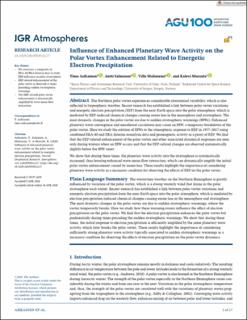Influence of Enhanced Planetary Wave Activity on the Polar Vortex Enhancement Related to Energetic Electron Precipitation
Journal article, Peer reviewed
Published version

Åpne
Permanent lenke
https://hdl.handle.net/11250/2765969Utgivelsesdato
2020Metadata
Vis full innførselSamlinger
Originalversjon
Journal of Geophysical Research (JGR): Atmospheres. 2020, 125 (9), e2019JD032137. 10.1029/2019JD032137Sammendrag
The Northern polar vortex experiences considerable interannual variability, which is also reflected to tropospheric weather. Recent research has established a link between polar vortex variations and energetic electron precipitation (EEP) from the near-Earth space into the polar atmosphere, which is mediated by EEP-induced chemical changes causing ozone loss in the mesosphere and stratosphere. The most dramatic changes in the polar vortex are due to sudden stratospheric warmings (SSWs). Enhanced planetary wave convergence and meridional circulation may cause an SSW, a temporary breakdown of the polar vortex. Here we study the relation of SSWs to the atmospheric response to EEP in 1957–2017 using combined ERA-40 and ERA-Interim reanalysis data and geomagnetic activity as a proxy of EEP. We find that the EEP-related enhancement of the polar vortex and other associated dynamical responses are seen only during winters when an SSW occurs and that the EEP-related changes are observed systematically slightly before the SSW onset.
We show that during these times, the planetary wave activity into the stratosphere is systematically increased, thus favoring enhanced wave-mean-flow interaction, which can dynamically amplify the initial polar vortex enhancement caused by ozone loss. These results highlight the importance of considering planetary wave activity as a necessary condition for observing the effects of EEP on the polar vortex.
